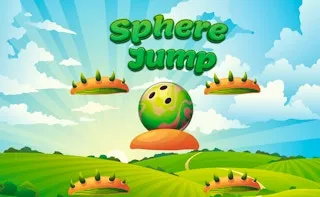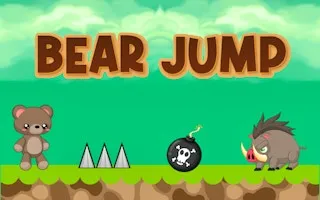Jumping Games
28 games in total. Page 1 of 1
Jumping Games: An Engaging and Fun Category
Jumping games offer a unique blend of physical activity and fun, providing players with exciting ways to improve coordination, balance, and stamina. Jumping games are one of the most enjoyable and engaging game categories, blending physical movement with fun and challenge. From classic activities like jump rope to modern adaptations in video games, these games appeal to all ages and fitness levels. Not only do they improve physical fitness, but they also enhance coordination, spatial awareness, and reaction time. This article delves into the jumping game category on PunyGame, highlighting its versatility, educational value, and entertainment appeal.The Joy of Jumping: More Than Just Fun
Jumping games are more than just simple physical activities; they are a way to boost cardiovascular health, develop motor skills, and encourage teamwork. These games are designed to keep players active, making them suitable for children and adults alike. A game like jumping rope, for example, has long been used to improve endurance and balance. It also sharpens reflexes and can be adapted into fun challenges to increase difficulty and competition. Jumping is also a central part of many professional sports. In track and field, events like the high jump, long jump, and triple jump push athletes to test their limits. Each of these variations incorporates different techniques, requiring precise timing and explosive strength. Beyond professional settings, jumping exercises are a staple in fitness routines across the globe, often used in plyometric training to improve muscle power and speed. These characteristics make jumping a highly versatile element, fitting seamlessly into everything from casual games to high-intensity sports training.Engaging Games for Kids and Adults Alike
For children, jumping games serve as an exciting way to develop physical and cognitive abilities. Popular games like hopscotch and "The Floor is Lava" are not just fun; they improve balance, coordination, and problem-solving skills. These activities engage the brain's proprioceptive system, which helps the body understand its position and movement in space. As kids jump, they are also working on their motor planning abilities, learning to navigate obstacles and improve their body awareness. Moreover, jumping games can be used in educational settings to help children develop foundational skills. For example, a game like animal jumps, where kids mimic the movements of different animals, combines learning with physical activity. By jumping like frogs or bouncing like kangaroos, children can work on their gross motor skills while having fun. This mix of education and play is crucial for encouraging a lifelong love of learning and physical fitness. Adults, too, can find immense benefits in jumping games. Games like jump rope can be adapted into high-intensity interval training (HIIT) routines, offering an effective way to burn calories and improve cardiovascular health. For those looking to enhance their athletic performance, incorporating jumping exercises into their workout can lead to better agility, coordination, and overall fitness.The Evolution of Jumping Games in the Digital World
Jumping games have found a home not only in playgrounds and fitness centers but also in the digital world. Video games centered around jumping challenges have gained immense popularity, offering players an engaging way to test their reflexes and hand-eye coordination. These games often feature simple mechanics, making them accessible to players of all ages and skill levels. For instance, in platform games, jumping is often the core mechanic. Players navigate through various levels by jumping over obstacles, avoiding hazards, and reaching goals. These games may seem straightforward, but they often require precise timing and quick reflexes. The blend of simplicity and challenge keeps players hooked, as they strive to improve their performance with each attempt. Games like "Jump King" and "Doodle Jump" are prime examples of how the jumping mechanic has evolved in the digital space. In "Jump King," players must scale a vertical world by executing perfectly timed jumps. One misstep can send them tumbling down, adding a layer of tension and excitement to the gameplay. Similarly, "Doodle Jump" uses an endless jumping mechanic, where players must ascend as high as possible, dodging obstacles and enemies along the way. These games not only entertain but also challenge the player’s coordination and strategic thinking.Jumping Games and Physical Health
One of the most important benefits of jumping games is the significant impact they have on physical health. Jumping is a full-body workout that improves cardiovascular endurance, burns calories, and strengthens muscles. It is often recommended as part of fitness routines aimed at weight loss, muscle toning, and improving overall health. Jumping exercises such as plyometrics are particularly effective for athletes looking to increase power and speed. These explosive movements target fast-twitch muscle fibers, leading to improved performance in sports that require quick bursts of energy, such as basketball, football, and tennis. Plyometric exercises, which include activities like jump squats, box jumps, and split jumps, help increase vertical leap and agility, making them a key component of many athletic training programs. Moreover, jumping exercises also contribute to better bone health. The impact from jumping helps increase bone density, which is crucial in preventing conditions like osteoporosis later in life. For older adults, incorporating low-impact jumping exercises, like jumping rope or trampoline workouts, can help maintain mobility and improve balance, reducing the risk of falls and injuries.Jumping for Cognitive Benefits
While jumping games are often seen as purely physical activities, they also offer significant cognitive benefits. These games require quick decision-making, hand-eye coordination, and spatial awareness. In games like hopscotch or jump rope challenges, players must anticipate movements and react in real-time, which enhances brain function and cognitive processing speed. Jumping exercises also stimulate the vestibular system, which is responsible for maintaining balance and spatial orientation. By engaging in activities that challenge this system, individuals can improve their balance, coordination, and overall motor skills. This is particularly beneficial for children, as it supports the development of essential skills that they will use throughout their lives. Additionally, jumping games can be a great way to relieve stress and improve mood. The physical activity involved in jumping releases endorphins, which are natural mood elevators. Whether it’s a child enjoying a game of hopscotch or an adult completing a jump rope workout, the joy and satisfaction that come from these activities contribute to better mental health and well-being.Why Jumping Games Are Timeless?
Jumping games have been a part of human culture for centuries. From ancient competitions in track and field to modern-day fitness routines, the act of jumping has remained a key component of physical activity and play. The simplicity of jumping, combined with its physical and cognitive benefits, makes it a timeless and universal activity. Whether it’s a child hopping in a game of hopscotch, an athlete perfecting their vertical leap, or a gamer navigating a virtual world, jumping games continue to captivate and challenge players of all ages. Their versatility, accessibility, and ability to blend fun with fitness ensure that jumping games will remain popular for generations to come.PunyGame © 2022. All rights reserved.



























